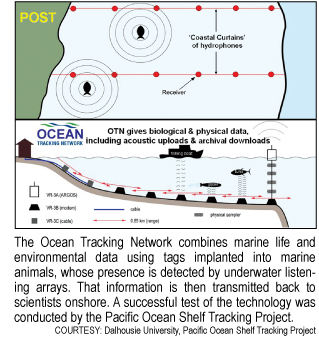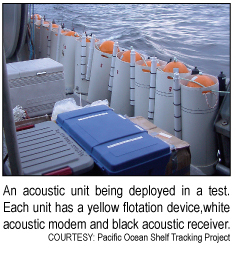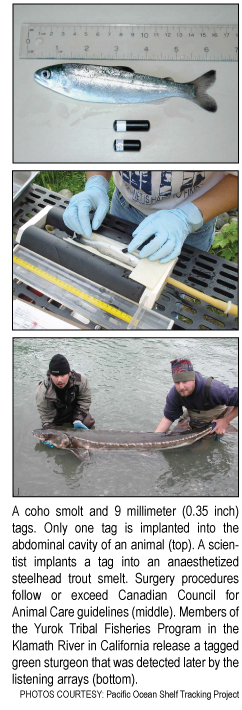|
 Ocean Tracking Network to shed light on undersea
life Ocean Tracking Network to shed light on undersea
life
By Stephen Leahy
[printer friendly page]
Imagine a spotlight on the ocean
floor just off of Halifax, Nova Scotia, powerful enough to create
a tube of light 400 metres or 1,312 feet in diameter and 20 kilometres
or 12 miles out to the edge of the Scotian shelf. And imagine
what this tube of light might reveal operating continuously.
While no such spotlight exists
yet, there soon will be something akin to it. A series of up
to 212 acoustic receivers, one every 732 metres (800 yards) or
so on the ocean floor, soon will create an “acoustic curtain”
180 kilometres (112 miles) offshore of Halifax to the edge of
the continental shelf that will detect fish, seals, whales and
other marine animals tagged with tiny ultrasonic transmitters.
“We’ll be able to detect
exactly when Atlantic salmon from the Gulf of Maine pass by on
their way to Newfoundland and Labrador,” said Ron O’Dor,
a researcher at Dalhousie University in Halifax. Sensors also
will detect temperature, salinity, pressure and current speeds,
offering new insight into when animals move and under what conditions.
This could fundamentally alter the management of fisheries. “Marine
scientists have never had continuous streams of data from the
ocean floor before,” he said.
 O’Dor is the
prime mover of the ambitious C$200 million (US$173 million) Canadian-led
Ocean Tracking Network (OTN). Canadian government research agencies,
including the Canada Foundation for Innovation, committed C$45
million (US$39 million) to the project in part because much of
the technology is Canadian.The grand vision is to establish as
many as 60 acoustic curtains around the world with one million
marine animals sending data in real time in 14 regions off of
all seven continents. O’Dor is the
prime mover of the ambitious C$200 million (US$173 million) Canadian-led
Ocean Tracking Network (OTN). Canadian government research agencies,
including the Canada Foundation for Innovation, committed C$45
million (US$39 million) to the project in part because much of
the technology is Canadian.The grand vision is to establish as
many as 60 acoustic curtains around the world with one million
marine animals sending data in real time in 14 regions off of
all seven continents.
Listening curtains
In the OTN scenario, transmitter tags as small as an almond or
up to an AA-sized battery are surgically implanted in animals.
Battery-powered acoustic receivers about the size of a large
soda bottle are attached to 200-kilogram (441-pound) steel railcar
wheels or concrete blocks to anchor them to the sea floor. Placed
at regular intervals about 50 to 200 receivers will form a line
or listening curtain up to 50 kilometres (31 miles) long in various
parts of the world. As a tagged animal approaches the listening
curtain, the nearest receiver logs the tag’s unique serial
number, the date and time. Movement patterns of individual animals,
including direction and speed, can be reconstructed using the
time of detection at different receivers and other listening
curtains.
Since most species stay along
the highly productive continental shelves, the receivers offshore
from Halifax, called the Halifax Line, will detect virtually
any tagged animal heading north from the Gulf of Maine and determine
if it returns. Continental shelves average about 80 kilometres
(50 miles) wide and the edge of the shelves occur at an average
depth of about 200 metres (660 feet) before falling off steeply
into the deep sea. Salmon and many other marine animals travel
extensively along the shelves. “With similar technology
in use in the Pacific, we found that the curtains are about 95
percent efficient. Only one in 20 tagged fish slips by undetected,”said
O’Dor.
 To
date, information on fish has been received from a research vessel
bouncing sonar acoustic signals off of a fish’s air-filled
swim bladder. But it has been difficult to get detailed information
about a fish’s movement, let alone the water conditions
at its location. To
date, information on fish has been received from a research vessel
bouncing sonar acoustic signals off of a fish’s air-filled
swim bladder. But it has been difficult to get detailed information
about a fish’s movement, let alone the water conditions
at its location.
A pilot project of receivers
and fish with transmitters, called the Pacific Ocean Shelf Tracking
project and stretching 1,750 kilometres (1,087 miles) from Oregon
through British Columbia and north to the Alaskan panhandle,
has been demonstrated successfully. The project, part of the
international Census of Marine Life, discovered for the first
time that young Pacific salmon suffered high mortality rates
along coastlines and not just in their natal rivers. On the East
Coast of North America, Atlantic salmon populations remain in
trouble. There have been high levels of mortality during migration
in recent years. The cause remains a scientific mystery.
Unraveling migration mysteries
About 350 salmon smolts on the East Coast of North America along
with striped bass, American eels and shad already have been tagged
with transmitters as part of other tracking projects, said John
Kocik, research fishery biologist at the National Oceanic &
Atmospheric Administration’s Northeast Fisheries Science
Center in Orono, Maine. “The OTN will greatly enhance our
ability to know where our tagged fish are going.”
Peter Smith, an oceanographer
at the Bedford Institute of Oceanography in Halifax who is in
charge of installing the Halifax Line, said he is waiting for
new equipment. In the Pacific the receivers can only upload their
data to boats passing overhead, thus requiring regular visits.
The Atlantic portion of the OTN will incorporate an improved
idea: “daisy chaining.” That means receivers in the
Halifax Line placed roughly 800 metres (2,625 feet) to 1,000
metres (3,282 feet) apart will transmit their data acoustically
from the furthest out to the next one closer to shore and so
on until the data are relayed by a cable system to Halifax, and
with only a few seconds’ delay.
“We’ll also supplement
the receivers with other sensors to get more information about
currents and temperatures,” said Smith. “It will be
a window on what’s going on down there.”
The data from the Halifax Line
as well as all other electronic curtains will be uploaded via
the Internet to the OTN central database in Halifax, enabling
scientists from around the world to understand animal movements.
This data will be invaluable to detect behaviour changes as the
oceans warm due to climate change. It also may be possible to
follow the spread of invasive species.
Dalhousie also plans in 2008
to place several antennas onto Gulf of Maine Ocean Observing
System (GoMOOS) buoys in the Gulf of Maine. Those antennas will
be able to upload data from the receivers on the ocean floor
and relay it to satellites that in turn will send it to computers
in the GoMOOS network on shore, said Mike Stokesbury, a biologist
at Dalhousie working on the OTN project.
“It’s all a little
overwhelming,” said Stokesbury.
Stephen Leahy is an environmental
journalist in Toronto, Canada.
|
Can
you hear me now?
Water
transmits sound five times faster than air and is an ideal environment
for acoustic communication as used by whales, dolphins and other
marine animals.
The Ocean
Tracking Network’s acoustic tags implanted in animals transmit
a series of ultrasonic sound “pings” called a pulse
train that contains a code. An individual marine animal with
its own code can then be identified when it comes close enough
to a receiver, which is essentially an underwater microphone.
All tags
are tested before use to make sure their ultrasonic pinging doesn’t
attract predators or affect other species.
The tags
are not removed from the marine animals, and depending on the
size, tags operate for 18 months to several years before batteries
die.
For more
information see the Ocean Tracking Network and the Pacific Ocean Shelf Tracking project.
|
|
![]()
